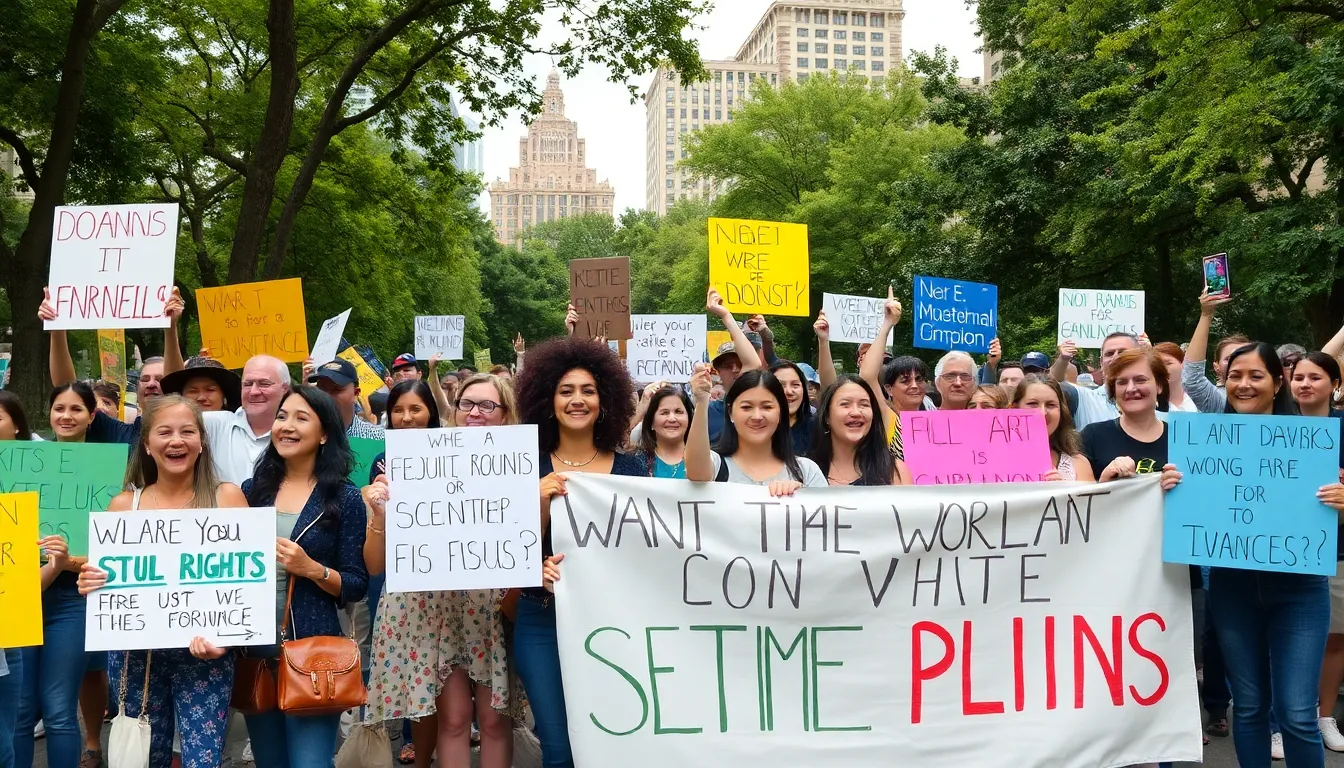In a world where political debates can feel like a bad reality show, political advocacy emerges as the unsung hero. It’s the art of speaking up, rallying the troops, and making sure that the voices of the people aren’t drowned out by the sound of crickets. Whether it’s fighting for climate change policies or advocating for social justice, political advocacy is where change begins and the drama unfolds.
Table of Contents
ToggleUnderstanding Political Advocacy
Political advocacy plays a crucial role in shaping society. It encompasses efforts to influence political decisions and legislation on behalf of specific issues or groups.
Definition of Political Advocacy
Political advocacy refers to the organized effort to promote specific policies, legislation, or changes within governmental systems. Advocates engage in various activities, including lobbying elected officials, mobilizing public support, and raising awareness. Groups and individuals often form coalitions to amplify their voices. This collective action seeks to address social, economic, and environmental issues. Nonprofit organizations, grassroots movements, and interest groups frequently participate in political advocacy.
Importance of Political Advocacy
Political advocacy significantly impacts democratic processes. It empowers individuals by giving them a platform to express their concerns and priorities. Advocacy enhances civic engagement by encouraging participation in the political system. It drives change across critical areas, such as health care, education, and environmental policy. Elected officials often respond to this pressure, leading to legislative changes that reflect public interests. Effective advocacy shapes public discourse, influencing perceptions and attitudes about critical societal issues.
Types of Political Advocacy

Political advocacy takes various forms, each with unique strategies to influence change. Understanding these types helps identify the most effective ways to advance specific causes.
Grassroots Advocacy
Grassroots advocacy mobilizes community members to promote initiatives or challenges. This form often involves organizing rallies, education campaigns, and petitions. Communities engage directly with policymakers, showcasing collective voices to drive impactful change. Examples include local environmental groups pushing for sustainable policies or social movements advocating for civil rights. Grassroots efforts rely on the passion of individuals, making them powerful catalysts for political involvement and awareness.
Lobbying
Lobbying represents a formal approach to influencing legislation. Organizations hire lobbyists to advocate for specific legislation, often within government settings. Professionals provide expertise, present data, and amplify agendas to decision-makers. Major issues like healthcare reform or corporate regulations often see significant lobbying efforts. Some lobbyists may focus on a single issue while others represent larger coalitions, highlighting the diverse interests that seek representation in the political landscape.
Media Advocacy
Media advocacy leverages various media channels to shape public opinion and influence policymakers. This type emphasizes strategic communication, utilizing platforms such as social media, journalism, and public service announcements. Campaigns often aim to bring awareness to urgent social issues like public health or environmental crises. Through targeted messaging, media advocacy drives public discourse and encourages citizen engagement. Organizations can create powerful narratives, leading to increased visibility for their causes and pressing decision-makers to address critical concerns.
Strategies for Effective Political Advocacy
Effective political advocacy employs various strategies that empower individuals and organizations to influence change. Understanding these strategies enhances the ability to create a meaningful impact.
Building Coalitions
Coalitions strengthen advocacy efforts by uniting diverse organizations and individuals around common goals. Collaborative partnerships increase resources and expertise, amplifying the collective voice. Community groups, nonprofit organizations, and advocacy networks come together to mobilize support. Shared messaging across platforms ensures consistent communication. Additionally, successful coalitions actively engage in outreach, tapping into the strengths of each member to drive initiatives forward. Such alliances exemplify the power of unified efforts, ultimately resulting in more significant political influence.
Utilizing Social Media
Social media serves as a vital tool for political advocacy by connecting advocates with broader audiences. Platforms like Twitter, Facebook, and Instagram enable real-time updates and engagement. Clear, compelling content captivates followers, encouraging them to share messages with their networks. Hashtags can help organize campaigns and promote visibility. Their capacity for rapid dissemination makes social media an effective channel for raising awareness around critical issues. Authentic dialogue fosters community engagement, reinforcing the commitment to advocacy goals. With strategic social media use, movements gain momentum and attract public support.
Engaging with Lawmakers
Engaging directly with lawmakers enhances advocacy effectiveness by establishing personal connections. Advocates should prepare clear, specific messages outlining their positions on relevant issues. Scheduling meetings with elected officials allows for face-to-face discussions, presenting facts and stories that resonate. Consistent follow-up is essential, ensuring that legislators remain informed about public sentiment. Sharing personal experiences also humanizes advocacy efforts, reinforcing the importance of grassroots voices in policy decisions. Building relationships with lawmakers cultivates ongoing dialogue, allowing advocates to influence legislative priorities effectively.
Challenges in Political Advocacy
Political advocacy faces numerous challenges that can hinder efforts to drive change. Understanding these obstacles is crucial for effective engagement.
Opposition and Pushback
Opposition can arise from various stakeholders, including political opponents and powerful interest groups. Many advocates encounter organized resistance aimed at undermining their messages or initiatives. Strong lobbying efforts from corporations frequently lead to pushback against grassroots movements. Community organizing efforts may experience backlash, particularly when advocating for controversial issues. Overcoming these challenges requires resilience and strategic planning, ensuring that messages remain clear and impactful.
Legal and Ethical Considerations
Navigating legal and ethical considerations remains essential in political advocacy. Complying with campaign finance laws can be complex, influencing how organizations mobilize resources. Various regulations dictate the limits on donations and expenditures, impacting advocacy strategies. Ethical dilemmas may arise when balancing personal beliefs with organizational goals, prompting advocates to reflect on their approach. Transparency is vital in maintaining trust with supporters and stakeholders. Following legal guidelines and ethical standards fosters credibility, enhancing advocates’ ability to effect meaningful change.
Political advocacy remains a powerful mechanism for effecting change in society. By empowering individuals and fostering civic engagement it creates pathways for meaningful dialogue and action on pressing issues. The diverse strategies employed—from grassroots movements to strategic lobbying—highlight the adaptability and resilience of advocates in the face of challenges.
As advocates continue to navigate the complex political landscape they must remain committed to ethical practices and transparency. This commitment not only builds trust but also enhances their ability to influence policy effectively. Ultimately the collective efforts of advocates can reshape legislation to better reflect the needs and desires of the public, driving progress in vital areas like health care and environmental policy.




